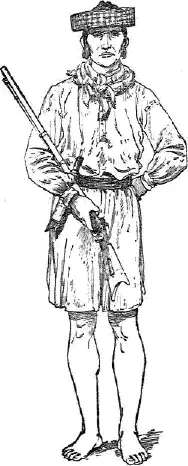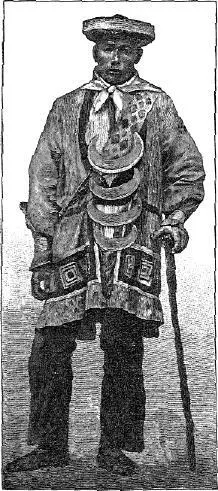Table of Contents
The women to a large extent share the qualities of the men. Some are proportionally tall and handsome, though, curiously enough, many, perhaps a majority, are rather under than over the average height of women. As a rule, they exhibit great bodily vigor. Large or small, they possess regular and agreeable features, shapely and well developed bodies, and they show themselves capable of long continued and severe physical exertion. Indeed, the only Indian women I have seen with attractive features and forms are among the Seminole. I would even venture to select from among these Indians three persons whom I could, without much fear of contradiction, present as types respectively of a handsome, a pretty, and a comely woman. Among American Indians, I am confident that the Seminole women are of the first rank.
Table of Contents
But how is this people clothed? While the clothing of the Seminole is simple and scanty, it is ample for his needs and suitable to the life he leads. The materials of which the clothing is made are now chiefly fabrics manufactured by the white man: calico, cotton cloth, ginghams, and sometimes flannels. They also use some materials prepared by themselves, as deer and other skins. Of ready made articles for wear found in the white trader’s store, they buy small woolen shawls, brilliantly colored cotton handkerchiefs, now and then light woolen blankets, and sometimes, lately, though very seldom, shoes.
Table of Contents

Seminole costume.
The costume of the Seminole warrior at home consists of a shirt, a neckerchief, a turban, a breech cloth, and, very rarely, moccasins. On but one Indian in camp did I see more than this; on many, less. The shirt is made of some figured or striped cotton cloth, generally of quiet colors. It hangs from the neck to the knees, the narrow, rolling collar being closely buttoned about the neck, the narrow wristbands of the roomy sleeves buttoned about the wrists. The garment opens in front for a few inches, downward from the collar, and is pocketless. A belt of leather or buckskin usually engirdles the man’s waist, and from it are suspended one or more pouches, in which powder, bullets, pocket knife, a piece of flint, a small quantity of paper, and like things for use in hunting are carried. From the belt hang also one or more hunting knives, each nearly 10 inches in length. I questioned one of the Indians about having no pockets in his shirt, pointing out to him the wealth in this respect of the white man’s garments, and tried to show him how, on his shirt, as on mine, these convenient receptacles could be placed, and to what straits he was put to carry his pipe, money, and trinkets. He showed little interest in my proposed improvement on his dress.
Having no pockets, the Seminole is obliged to submit to several inconveniences; for instance, he wears his handkerchief about his neck. I have seen as many as six, even eight, handkerchiefs tied around his throat, their knotted ends pendant over his breast; as a rule, they are bright red and yellow things, of whose possession and number he is quite proud. Having no pockets, the Seminole, only here and there, one excepted, carries whatever money he obtains from time to time in a knotted corner of one or more of his handkerchiefs.
The next article of the man’s ordinary costume is the turban. This is a remarkable structure and gives to its wearer much of his unique appearance. At present it is made of one or more small shawls. These shawls are generally woolen and copied in figure and color from the plaid of some Scotch clan. They are so folded that they are about 3 inches wide and as long as the diagonal of the fabric. They are then, one or more of them successively, wrapped tightly around the head, the top of the head remaining bare; the last end of the last shawl is tucked skillfully and firmly away, without the use of pins, somewhere in the many folds of the turban. The structure when finished looks like a section of a decorated cylinder crowded down upon the man’s head. I examined one of these turbans and found it a rather firm piece of work, made of several shawls wound into seven concentric rings. It was over 20 inches in diameter, the shell of the cylinder being perhaps 7 inches thick and 3 in width. This head-dress, at the southern settlements, is regularly worn in the camps and sometimes on the hunt. While hunting, however, it seems to be the general custom, for the warriors to go bareheaded. At the northern camps, a kerchief bound about the head frequently takes the place of the turban in everyday life, but on dress or festival occasions, at both the northern and the southern settlements, this curious turban is the customary covering for the head of the Seminole brave. Having no pockets in his dress, he has discovered that the folds of his turban may be put to a pocket’s uses. Those who use tobacco (I say “those” because the tobacco habit is by no means universal among the red men of Florida) frequently carry their pipes and other articles in their turbans.

Key West Billy.
When the Seminole warrior makes his rare visits to the white man’s settlements, he frequently adds to his scanty camp dress leggins and moccasins.
In the camps I saw but one Indian wearing leggins (Fig. 62); he, however, is in every way a peculiar character among his people, and is objectionably favorable to the white man and the white man’s ways. He is called by the white men “Key West Billy,” having received this name because he once made a voyage in a canoe out of the Everglades and along the line of keys south of the Florida mainland to Key West, where he remained for some time. The act itself was so extraordinary, and it was so unusual for a Seminole to enter a white man’s town and remain there for any length of time, that a commemorative name was bestowed upon him. The materials of which the leggins of the Seminole are usually made is buckskin. I saw, however, one pair of leggins made of a bright red flannel, and ornamented along the outer seams with a blue and white cross striped braid. The moccasins, also, are made of buckskin, of either a yellow or dark red color. They are made to lace high about the lower part of the leg, the lacing running from below the instep upward. As showing what changes are going on among the Seminole, I may mention that a few of them possess shoes, and one is even the owner of a pair of frontier store boots. The blanket is not often worn by the Florida Indians. Occasionally, in their cool weather, a small shawl, of the kind made to do service in the turban, is thrown about the shoulders. Oftener a piece of calico or white cotton cloth, gathered about the neck, becomes the extra protection against mild coolness in their winters.
Table of Contents

Seminole costume.
The costume of the women is hardly more complex than that of the men. It consists, apparently, of but two garments, one of which, for lack of a better English word, I name a short shirt, the other a long skirt. The shirt is cut quite low at the neck and is just long enough to cover the breasts. Its sleeves are buttoned close about the wrists. The garment is otherwise buttonless, being wide enough at the neck for it to be easily put on or taken off over the head. The conservatism of the Seminole Indian is shown in nothing more clearly than in the use, by the women, of this much abbreviated covering for the upper part of their bodies. The women are noticeably modest, yet it does not seem to have occurred to them that by making a slight change in their upper garment they might free themselves from frequent embarrassment. In going about their work they were constantly engaged in what our street boys would call “pulling down their vests.” This may have been done because a stranger’s eyes were upon them; but I noticed that in rising or in sitting down, or at work, it was a perpetually renewed effort on their part to lengthen by a pull the scanty covering hanging over their breasts. Gathered about the waist is the other garment, the skirt, extending to the feet and often touching the ground. This is usually made of some dark colored calico or gingham. The cord by which the petticoat is fastened is often drawn so tightly about the waist that it gives to that part of the body a rather uncomfortable appearance. This is especially noticeable because the shirt is so short that a space of two or more inches on the body is left uncovered between it and the skirt. I saw no woman wearing moccasins, and I was told that the women never wear them. For head wear the women have nothing, unless the cotton cloth, or small shawl, used about the shoulders in cool weather, and which at times is thrown or drawn over the head, may be called that. (Fig. 63.)
Читать дальше















